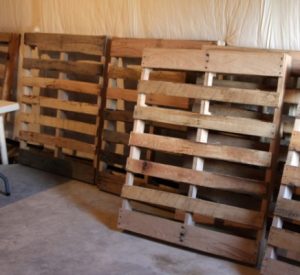Pallets play an integral role in the transport and storing of numerous materials across multiple industries. If used incorrectly, pallets pose hazards that can lead to employee injuries, property loss, and costly fines. Although they are useful and readily available, you should always take caution when using pallets to avoid pallet hazards.
All About Pallet Hazards
Storing Idle Pallets
Pallets are often found standing on end when not in use. When standing upright, the unstable pallet can fall over and injure a worker. Occupational Safety and Health Administration (OSHA) clearly states “Cargo, pallets and other material storied in tiers shall be stacked in such a manner as to provide stability against sliding and collapse” (Standard 1917.14). Empty pallets lying flat for employees to step over also present a hazard. This can lead to tripping, falling, and twisted ankles. Another risk is protruding nails or splintered wood that could cut workers.
Fire Hazard
According to the National Fire Protection Association (NFPA), storing empty pallets in a central area is common, but such pallets create a fire potential far beyond the capacity of most sprinkler systems. NFPA bases its recommendations on type of automatic sprinkler system and pallet storage configuration, including the height and clearance from other combustibles. The risk of fire is so serious  that the NFPA recommends storing pallets away from the main facility. However, whether stored inside or out, a significant fire hazard still exists because of the high level of combustibility of pallets.
that the NFPA recommends storing pallets away from the main facility. However, whether stored inside or out, a significant fire hazard still exists because of the high level of combustibility of pallets.
Pallets Obstructing Exit Routes
Pallets loaded with material take up space. When a facility’s storage space is already in high demand, palletized material may be improperly stored. They become a serious hazard if they block exits or impede egress. OSHA has several regulations relating to this safety hazard:
1910.22(c)
Access and egress. The employer must provide, and ensure each employee uses, a safe means of access and egress to and from walking-working surfaces.
1910.37(a)(3)
Exit routes must be free and unobstructed. No materials or equipment may be placed, either permanently or temporarily, within the exit route. The exit access must not go through a room that can be locked, such as a bathroom, to reach an exit or exit discharge, nor may it lead into a dead-end corridor. Stairs or a ramp must be provided where the exit route is not substantially level.
1926.34(c)
Means of egress shall be continually maintained free of all obstructions or impediments to full instant use in the case of fire or other emergency.
1926.250(a)(3)
Aisles and passageways shall be kept clear to provide for the free and safe movement of material handling equipment or employees. Such areas shall be kept in good repair.
If found in violation, OSHA can levy fines from hundreds to tens of thousands of dollars. The amount of the penalty depends on OSHA’s view of the potential for serious injury. OSHA will assess higher penalties if they believe that the employer was aware of the hazard and willfully committed the violation and for repeat violations.
Carefully consider the appropriate storage of pallets whether idle or in use. Additionally, evaluate if all palletized products in a facility are necessary. A facility may not be able to eliminate all pallet use but, when possible, reducing the number of pallets in a facility can directly reduce the risk of injury and potential property damage.
